Yesterday morning I spotted this female American Kestrel perched on a far-off rock to the west on Antelope Island. She was much too far away for decent photographs (as is obvious from the mediocre quality of these first five photos) but when I see raptors at most any distance it’s my practice to “scope them out” through my lens so I can ID them and look for anything unusual or interesting.

I took a couple of shots for documentary purposes but at first I didn’t notice anything noteworthy about her except for the keratin flaking off of her beak.

But then she scratched her face with her foot. Jesses! Those damned jesses again. In this shot you can see anklets above both feet and the jess on the left leg.
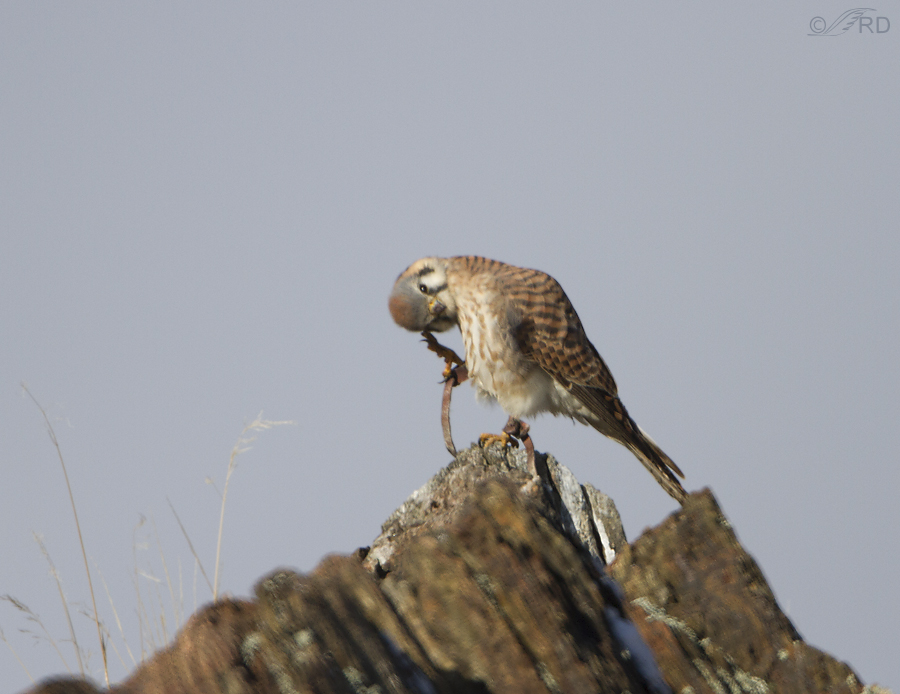
She perched and preened on the rock for quite a while and a few minutes later she scratched with her other foot which provided a good look at the jess on the right ankle.
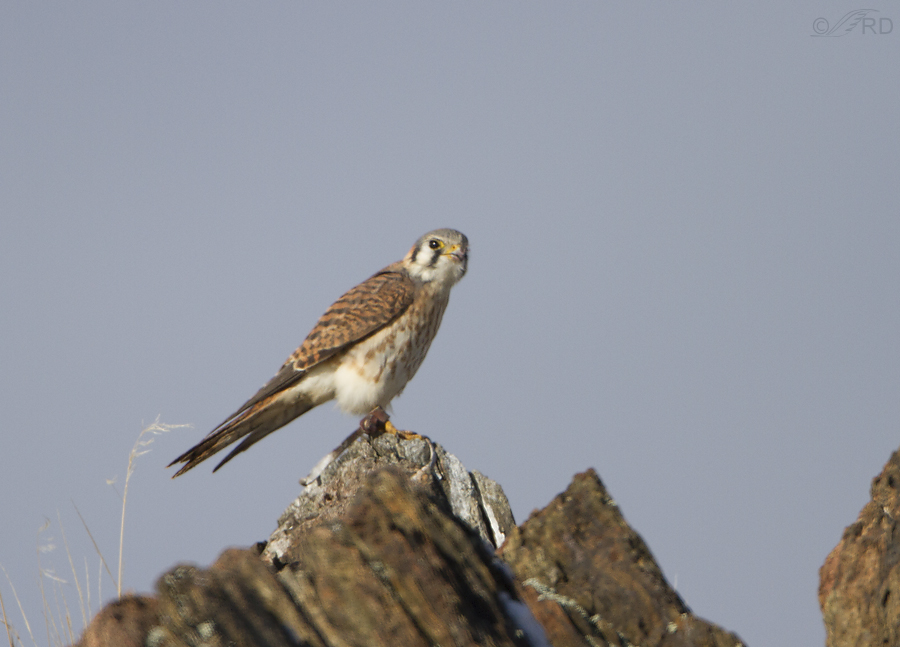
I’m including this shot for a look at her right side, in the unlikely event that some local falconer may recognize her.
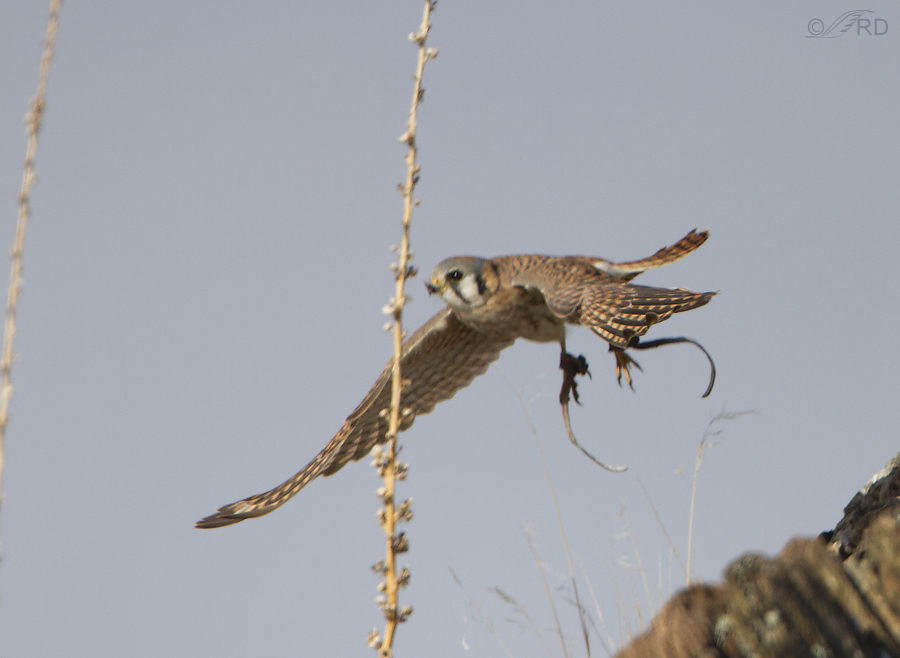
I hung around for a long time in the hopes of catching her at take-off for a better look at both jesses and anklets. As luck would have it, when it happened they were both in shade and I lost focus on the bird but the photo still provides a decent look at the jesses.
I’m deeply troubled by this event and I’ll provide a little background as to why (some of this may be old news to regular readers of my blog).

Three years ago we found this escaped male kestrel hanging around Farmington, Utah. For weeks I’d see him nearly every morning on my way to Farmington Bay WMA for my bird photography. I reported the bird to the Utah Department of Natural Resources (DNR) and to a local falconry group. The “owner” of the bird was eventually located and trapped him but it wasn’t long before the kestrel escaped a second time. The bird returned to Farmington where I continued to see it on most mornings for quite a while. I don’t know the eventual fate of the bird.
But I can guess. Falconers have informed me that these particular jesses are illegal, I suspect because they are too long. They are an obvious death trap because of the virtual certainty that they would become entangled around a branch or wire and kill the kestrel. And a miserable death it would be.
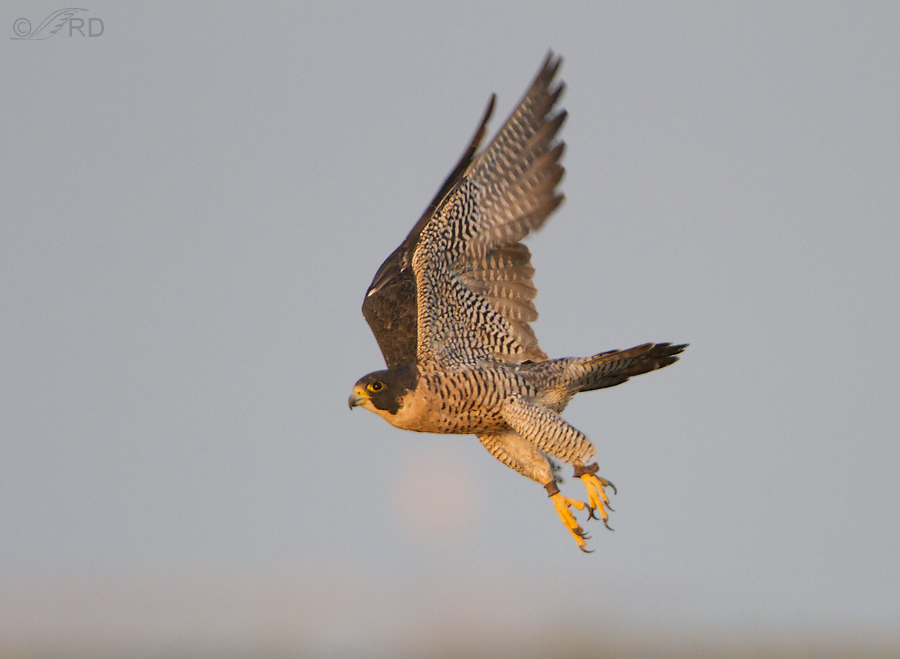
Then, on September 17th of this year, I found this Peregrine Falcon along the causeway to Antelope Island. The falconry anklets on both feet are clearly visible, so the peregrine is obviously another escaped falconry bird. Once again I reported this bird to DNR (both the Salt Lake City and Ogden offices) and was told they would “check it out”.
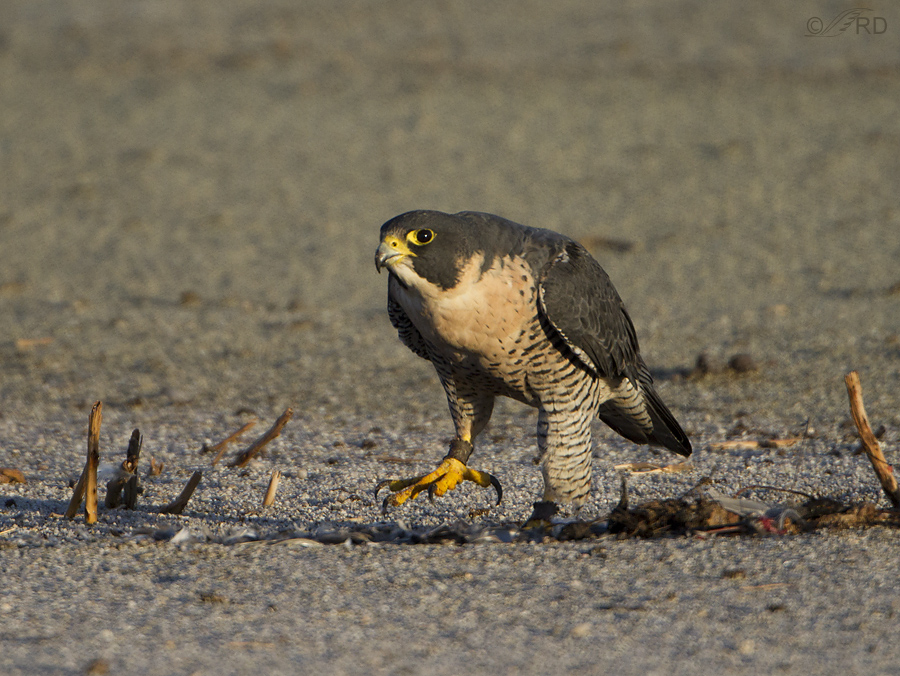
But almost a month later, on October 14, 2012, the falcon was still actively hunting along the causeway. In this photo you can see both anklets, though the one on the right ankle is most obvious. In those four weeks I noticed this bird several times along the causeway but never did I see any DNR or falconry folks out there attempting to trap the bird (nor did I see them at all, even though I was out there on most mornings). And I never did heard back from DNR.

In this take-off shot, taken the same morning, both anklets are clearly visible.
Over the long haul, jesses on raptors in the wild can be extremely dangerous, for obvious reasons. Even anklets could be a significant hindrance to a bird attempting to eke out survival in the wild. Anklets, with their open eyelets (those eyelets can be seen in this photo), have the potential to snag and hang up the bird. Many of these birds expend significant amounts of time, effort and energy trying to remove jesses, anklets and even falconry bands. That’s energy they can’t afford to waste.
I’m seeing a pattern that I find disturbing. I was troubled by the first two sightings I’ve reported here and I blogged about those concerns but I was somewhat reassured by responses from the falconry community that these were unusual, isolated incidents. But it seems to me that I would not see three different escaped falconry birds (one of which escaped twice) in such a relatively short period of time unless this were a larger problem than I’ve been led to believe. If I’ve seen three, how many more of them are out there that I haven’t seen?
I’m still trying to reconcile my respect for the responsible actions of the vast (and I do mean vast) majority of falconers with this troubling pattern of falconry birds I’m seeing in the wild with their anklets and/or jesses still attached. And I must admit that my support of falconry as a “sport” has once again taken a significant hit.
Ron
Note: As I said, I have blogged in the past on this issue. In the comments on those posts there has been extensive discussion on the ethics of falconry and the positive influences falconers have had for many years in the areas of conservation and education. For those who may be interested I’ve provided links to those posts below.
Escaped Falconry Bird – Peregrine Falcon


Hey Ron,
Not sure about the rules and regs stateside but here in Canada, legit education and falconry birds need to have a band.
Legit falconry birds in the US did need to be banded – the falconers had to take them them into the local Fish & Wildlife office for banding with what was basically a zip-tie encased in soft plastic tubing – but I’m not sure that’s still the case with the revision of the regs. Obviously, purchased captive-bred birds all must have a seamless band, but it’s not numbered in any way. Education birds have never had to be banded.
Progress Report #2
I spent much of this morning on the island with Becka, a falconer with the proper permits to trap this kestrel and remove her anklets and jesses. The purpose of this trip was simply to point out to Becka the area where the kestrel hangs out and see if we could locate her (we didn’t). Since this is a state park, further arrangements need to be made with park officials and DNR before attempts at trapping can begin. I’ll follow up here if there are further developments.
I’m becoming increasingly convinced that this kestrel and the Peregrine Falcon mentioned in this post are birds that have been hijacked illegally by rogue falconers (Youtube falconers, if you will) and that organized falconry likely had nothing to do with these birds. I hope that’s the case.
Thank you for this post – and even more for saying that you would keep us up to date with further developments. Those jesses look like a sad and ugly death waiting to happen and I so hope that she can be trapped and saved. And believe me ‘trapped and saved’ is a juxtaposition of words which doesn’t sit comfortably with me.
ARGH! This is INFURIATING!!!! Irresponsible, unreliable, rotten pretend-falconers!
Ron, I hope this comment isn’t a duplicate, feel free to delete if it is. I left one earlier but it didn’t post for some reason.
I love this thread for the action and potential resolution it instigated. Based on what Mark wrote, it seems likely it could be a rogue “operator,” although that’s obviously not my area of expertise. Please keep us posted on this story if there’s a verifiable outcome.
By the way, I wish I had the forbearance you do in not posting “mediocre” shots. You know what a fan I am of your work and the level of skill and talent visible in your shots. So, I do understand what you’re saying. It’s just that for me, if I limited myself to exceptional shots, I would never have anything to blog about. 🙂 As always, I enjoy your consistently beautiful posts.
Ingrid, there was no duplicate comment that I’m aware of on this end.
This situation is still developing and I’m encouraged. The president of NAFA (North American Falconry Association) is now involved with us in the process of developing a better reporting system for these escaped birds – one that is available to the public and not just to falconers, as is the case now.
We’re hoping to trap the female kestrel soon and remove her jesses and anklets. Assuming a licensed trapper is located, I will likely meet him/her on the island to point out the location where the bird hangs out. And yes, I’ll update any significant developments here.
Regarding me “not posting mediocre shots” – I’ll sincerely return the compliment and say that I dearly wish that I had your writing skills. Virtually ever time I read one of your blog posts (http://www.thefreequark.com/ for anyone interested) I marvel at your skill at making a logical, literate case for your point of view. Your latest post “RIP – Wolf 832F” is a case in point.
Progress report:
Thanks to the efforts of Mark Runnels, I’ve been in touch with Christopher Wall, president of the Utah Falconers Association. We’re in the very early stages of planning for trapping the female kestrel on the island and, as suggested by Christopher, developing a more effective system for reporting “lost” falconry birds. Some of this may take a while but I’ll report back on any significant developments.
Ron – Falconry birds DO take off at times and usually it’s not the end of the world, as they know how to hunt and SHOULD just have the anklets, as does the peregrine. (I won’t get into WHY they take off – but suffice it to say that they are flying free and always have that option, every day.) Escaping with jesses on is another story. The female kestrel you just saw obviously has leather anklets that look stiff, old and NOT well-oiled. They are not likely to get tangled around things though could, of course, get stuck in a crack. IF a falconry bird is flown with jesses on, they should be ‘field jesses’ that have no hole in the ends, so less likely to get stuck on a twig or thorn or whatever. Hers look so stiff I can’t tell if they have holes or not. You might also report these birds to a local rehab center, if there is one – they might be able to come trap the bird (we do it as necessary – but then any of our local falconers who lose a bird usually contact us, as the public seeing a bird like that usually contacts us first)… or if there’s a state falconry association, a local falconer will usually come trap a lost bird and hold it until the correct falconer is located. Unfortunately, kestrels are one of the two species allowed to apprentice falconers in most states (red-tailed hawks are the other) and tho such apprentices are supposed to be working closely with their sponsor, mistakes are more likely to happen. It’s also possible this is an escaped education bird – it has happened to us due to accidents or equipment malfunction. Not often – but it does happen. The male kestrel you show with the grossly over-long and shredded jesses should never have been returned to the falconer, IMHO. The state wildlife folks don’t really have a way to trap a bird – they should know who LOST a bird, if it’s a local falconer – but peregrines could be from anywhere. That’s why the local falconers association is a better bet, as they’ll communicate with each other all up and down a flyway about a lost bird.
Thanks very much, Louise. I’m hoping to hear from the Utah Falconers Association soon (see comment by Mark Runnels, below).
Hi Ron, There is something very odd going on up there in Utah. I have been bird watching, and flying falconry birds for over 25 years and I have never seen an escaped falconry bird (unless it is one that we were trying to recover). I spoke with a friend that runs a banding station on the coast and he said that he had seen one, but it was back in the early ’80s. Between us, we have captured, and/or banded and released thousands of raptors without finding a single falconry bird in the past 20 years. For you to have found three in three years is unprecedented.
The other odd thing is that these are Kestrels. Kestrels are a very small fraction of the total number of falconry birds. They are delicate to keep, and very limited hunters. There are 107 falconers in Oklahoma, with about 300 birds. I am aware of a total of two kestrels being trained for falconry. (There are a number more in rehab facilities). If my math is right, that is less than 1/2 of 1% of all falconry birds are Kestrels, yet you have found two escaped Kestrels with falconry equipment. Combine that with an unbanded Peregrine, and something smells rotten. This is most likely NOT the work of a falconer. The pretty colors and calm nature of the Kestrels make them very attractive to the “cool pet” crowd.
I don’t know anyone in the Utah Falconer’s Association, but I have their contact information and I am going to forward a link to your site to them. They need to figure out what is going on and correct the situation. I think you have a rogue person in the area (not a falconer) that is responsible for all three birds. Hopefully they have someone in the area that can gently trap this kestrel and remove the hardware.
The good news (if there can be any) is that this Kestrel has the modern two piece jesses on. She should be able to easily pull the straps out and the anklets will rot away in a year or so. In addition, they are field jesses which means that they don’t have holes or slits in them that will get hung up. Even if she doesn’t pull them, there is a good chance that she will be fine until they rot away.
If they contact you, can you help them locate this bird to help her?
Please let me know if you don’t hear from them in the next few days. We need to get this resolved and this person straightened out!
Thanks,
Mark
Thanks very much, Mark. I was hoping you’d weigh in on this.
What you’re saying makes sense to me. If it is a “rogue” doing this I would very much like to put an end to his/her illegal and unethical activities.
I hope that someone from UFA does contact me and if so I can direct them to where this kestrel hangs out. I suspect it to be the same female that I’ve seen in the area in the recent past. If so, she may be relatively easy to re-locate.
I’ll let you know if they contact me.
An additional thought, Mark. I believe that the first jessed Kestrel I found, the male, was being trained by a licensed falconer (or at least an apprentice) – not a “rogue” in the traditional sense. I met him. In fact, after he re-captured the bird he even brought it to my home for a “visit”. He seemed like a nice guy and a responsible person toward his bird. But then it escaped again.
Hi Ron,
That’s too bad. It is unfortunate that we can’t keep the ranks “pure”, but the good news is that these types of irresponsible people either shape up into good falconers, or find another hobby that isn’t so demanding.
I hope Christopher will be in touch with you soon.
I wish I lived closer.
Mark